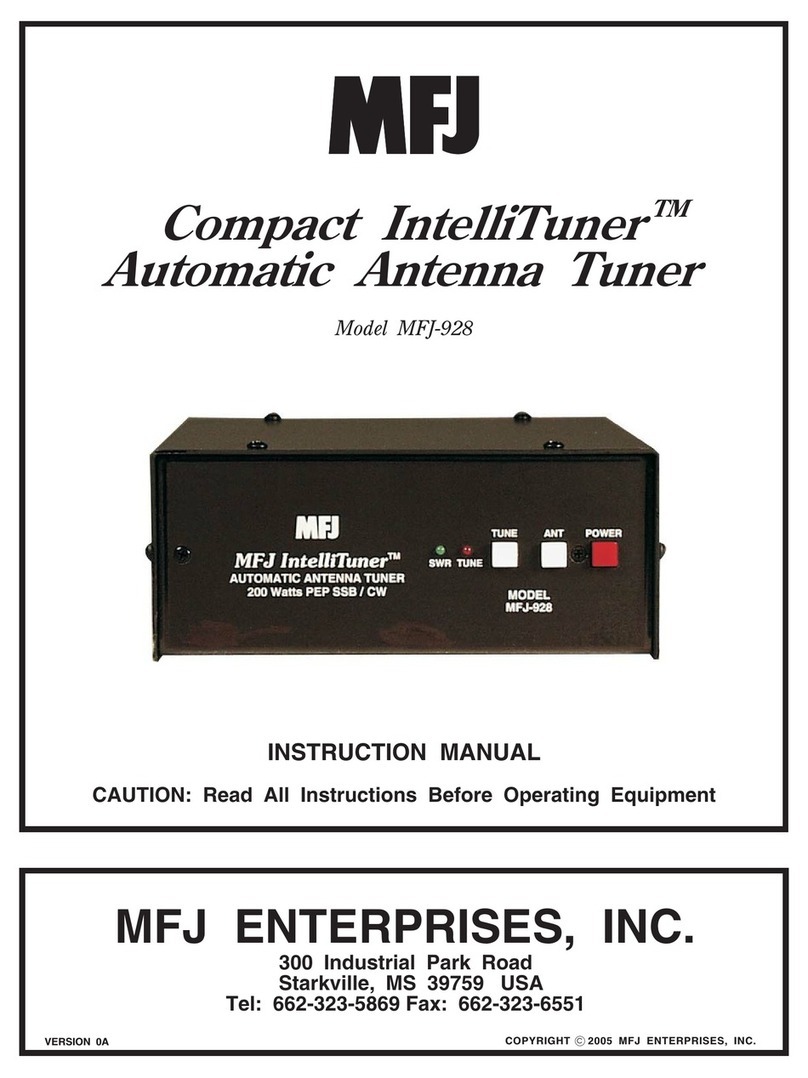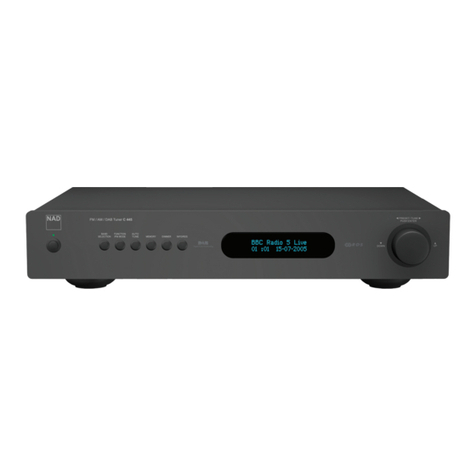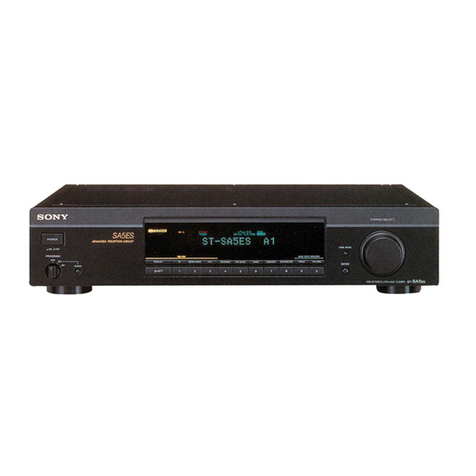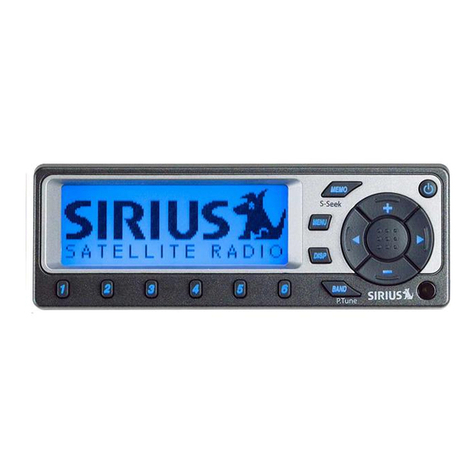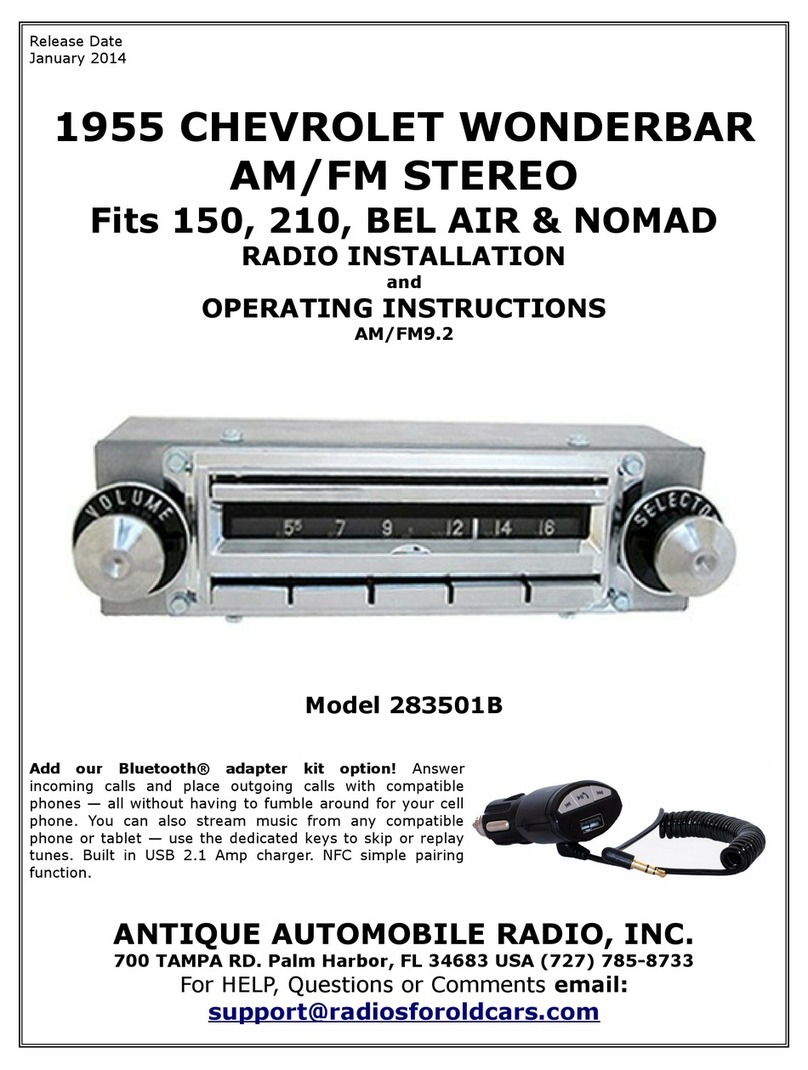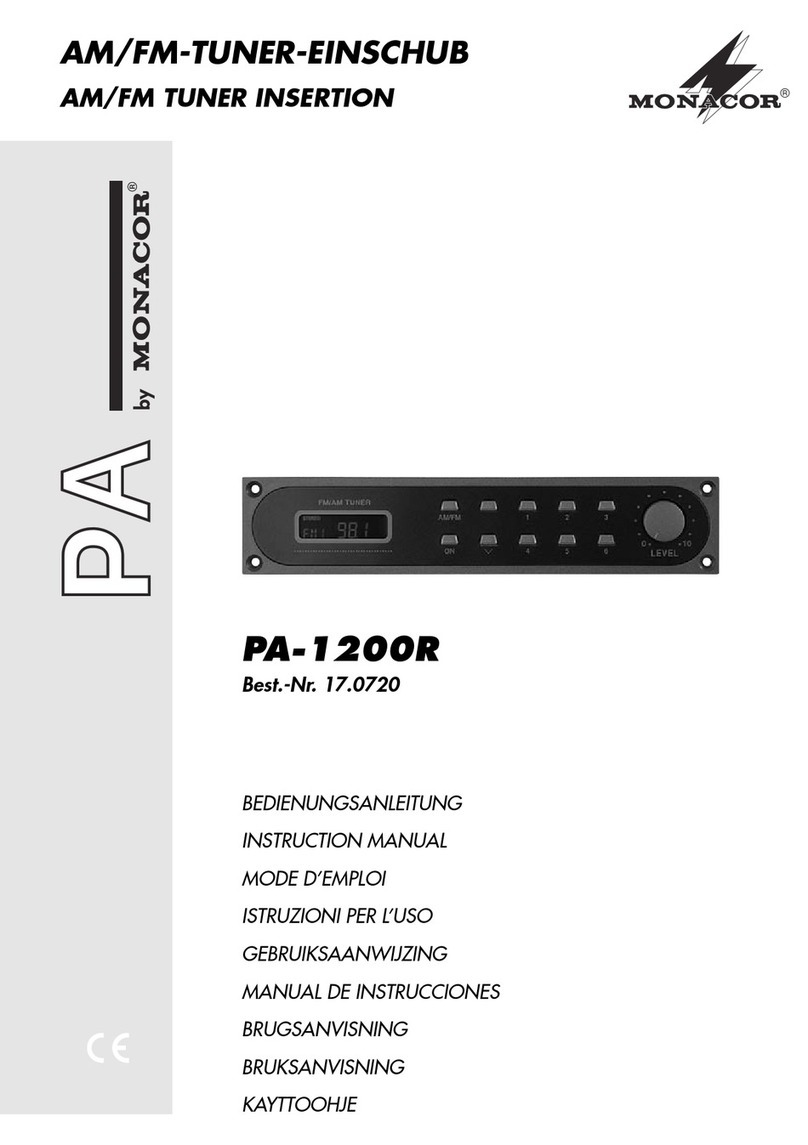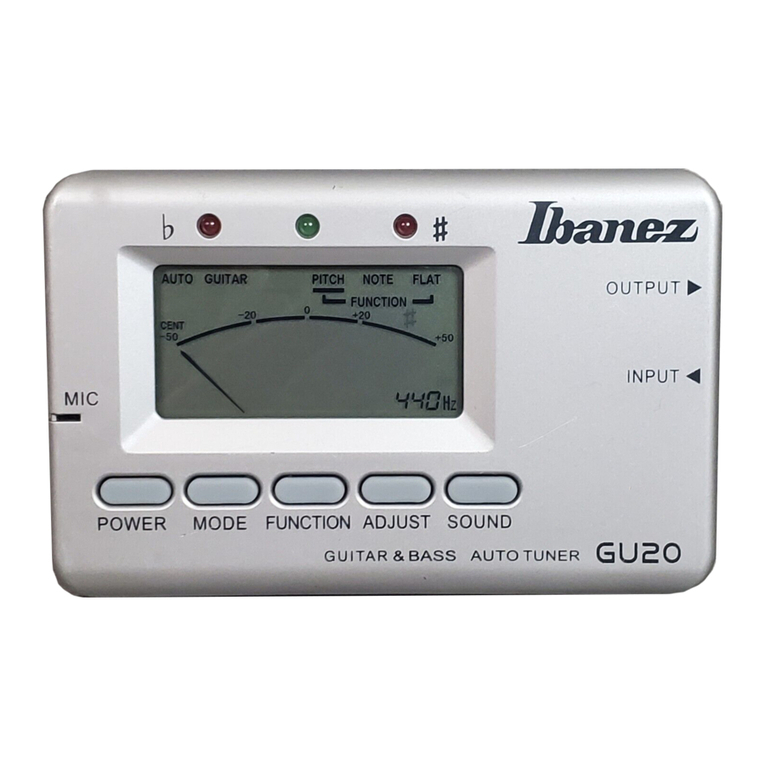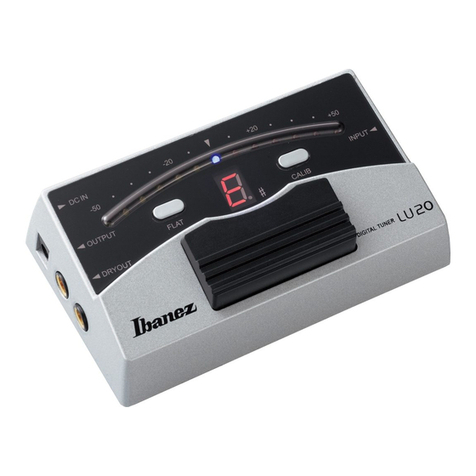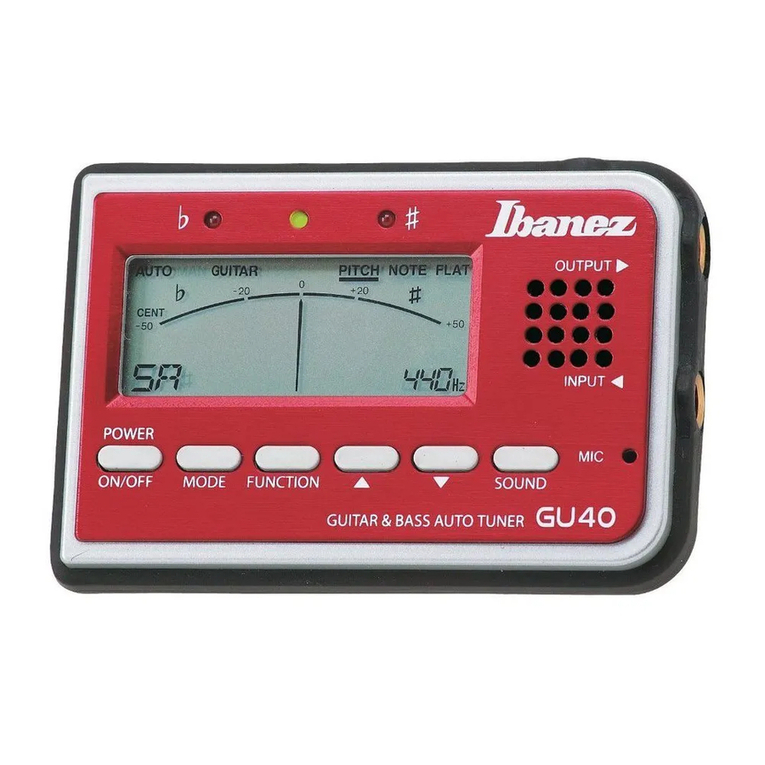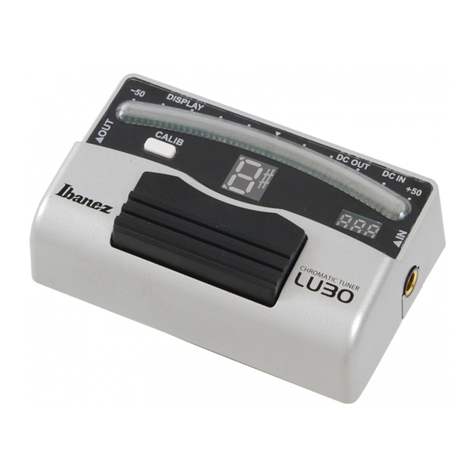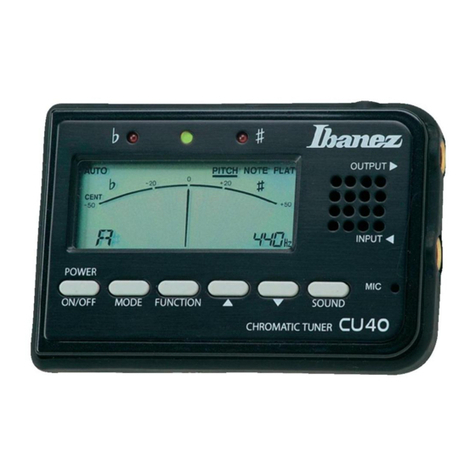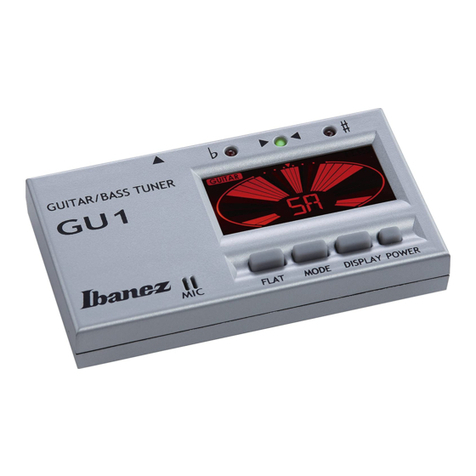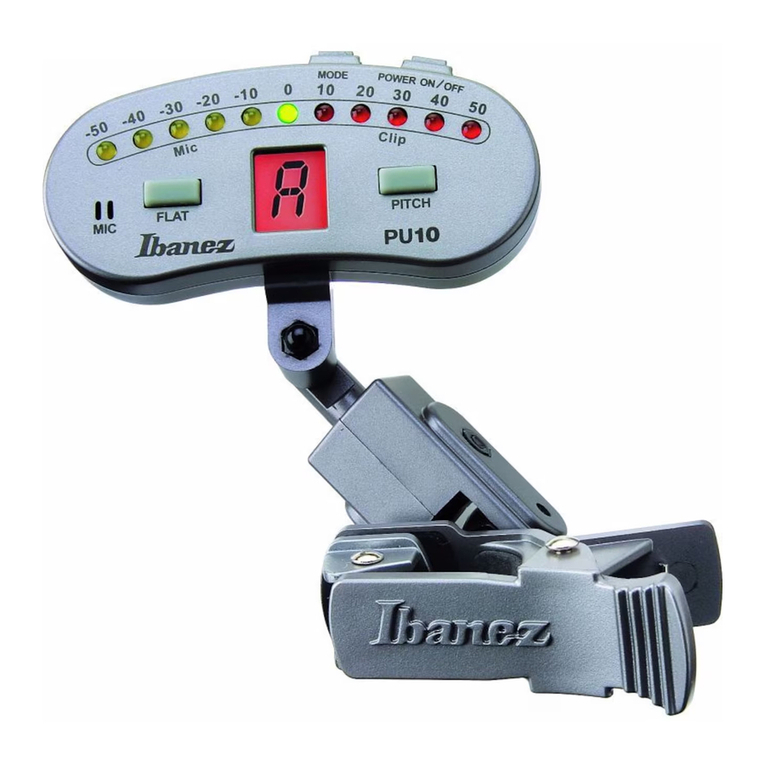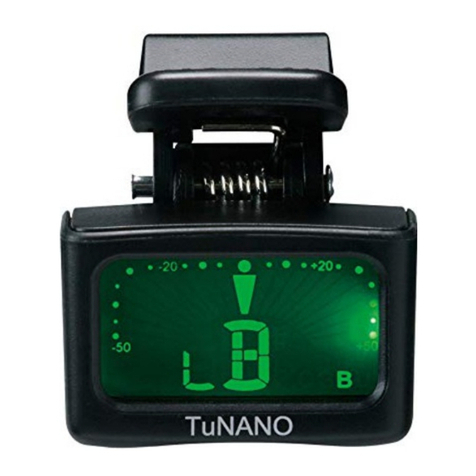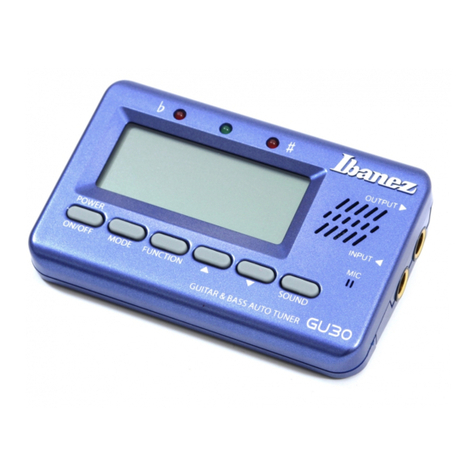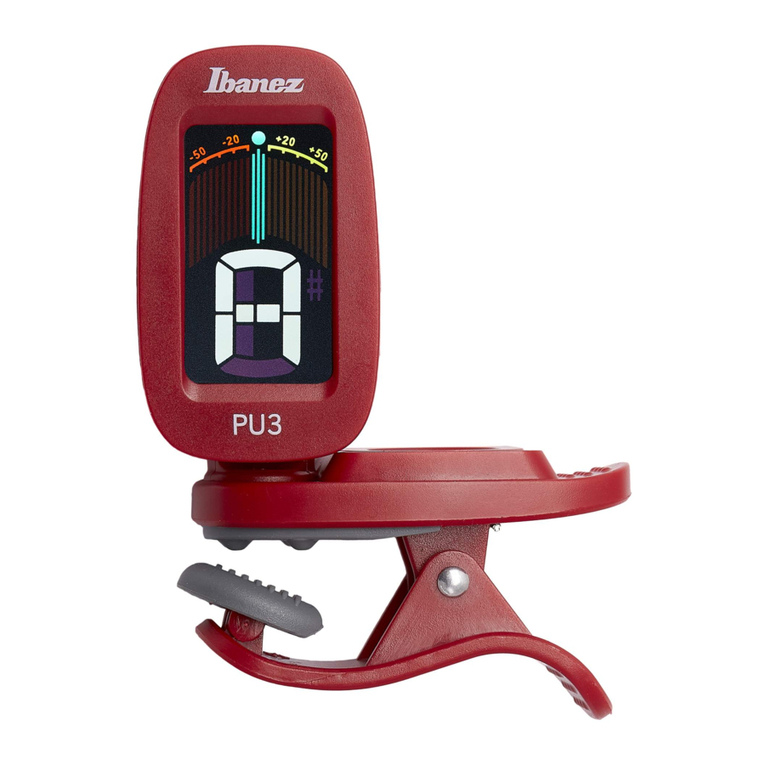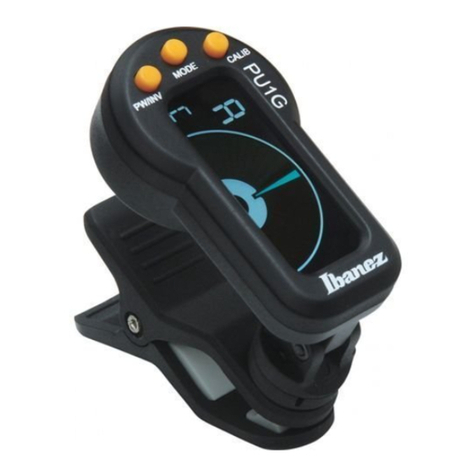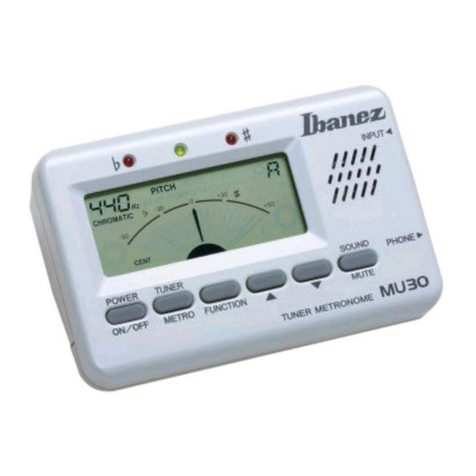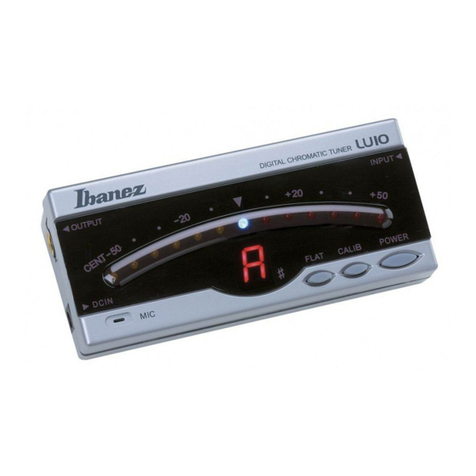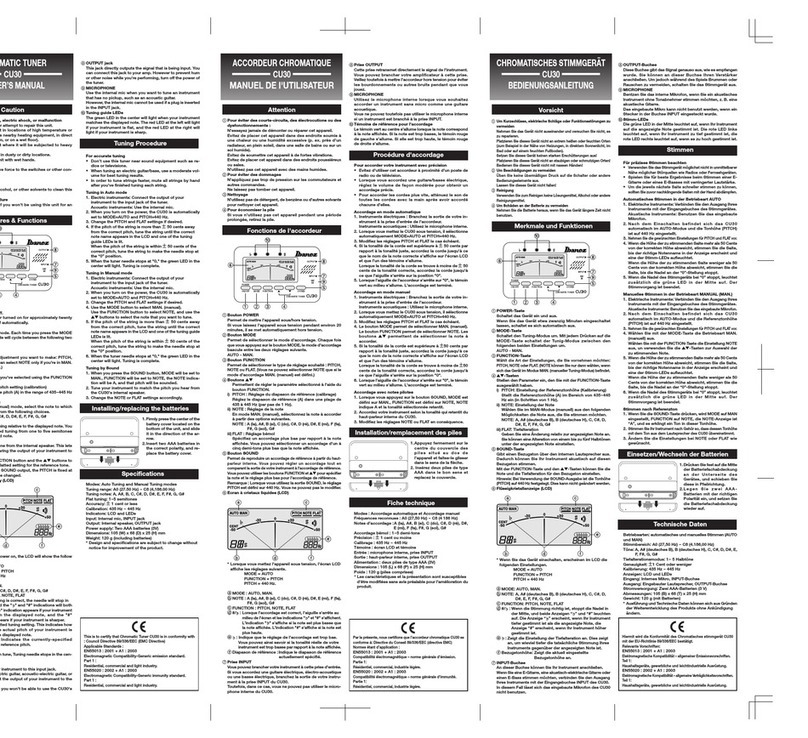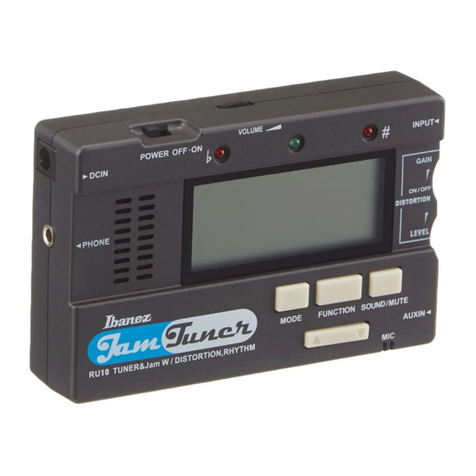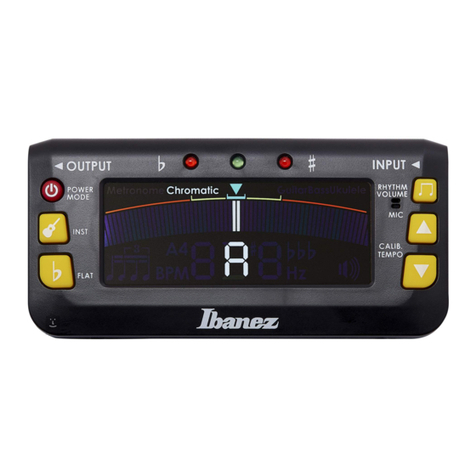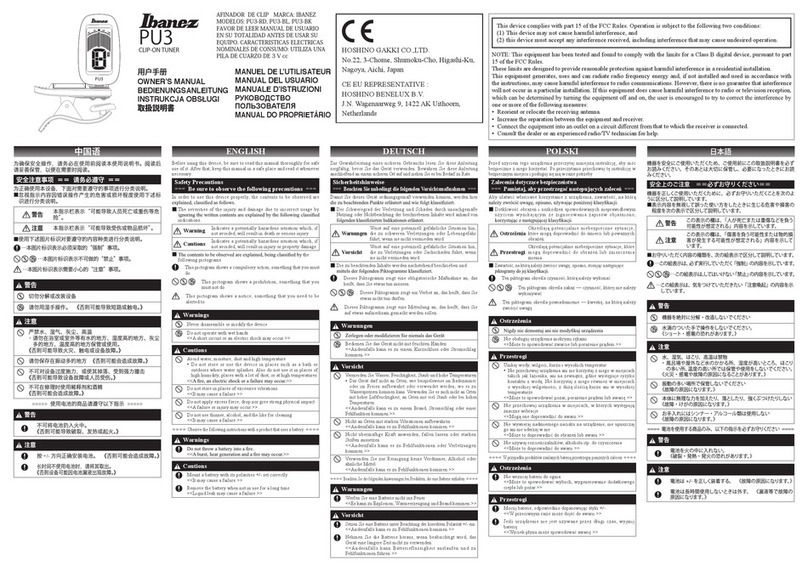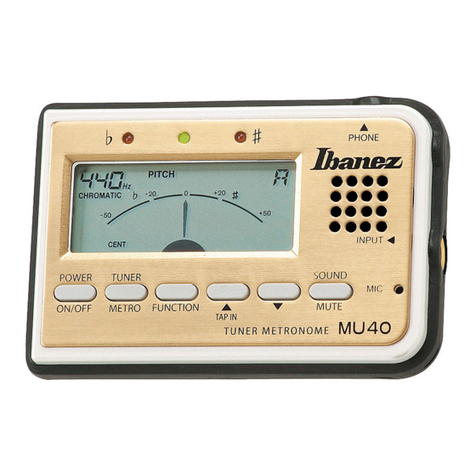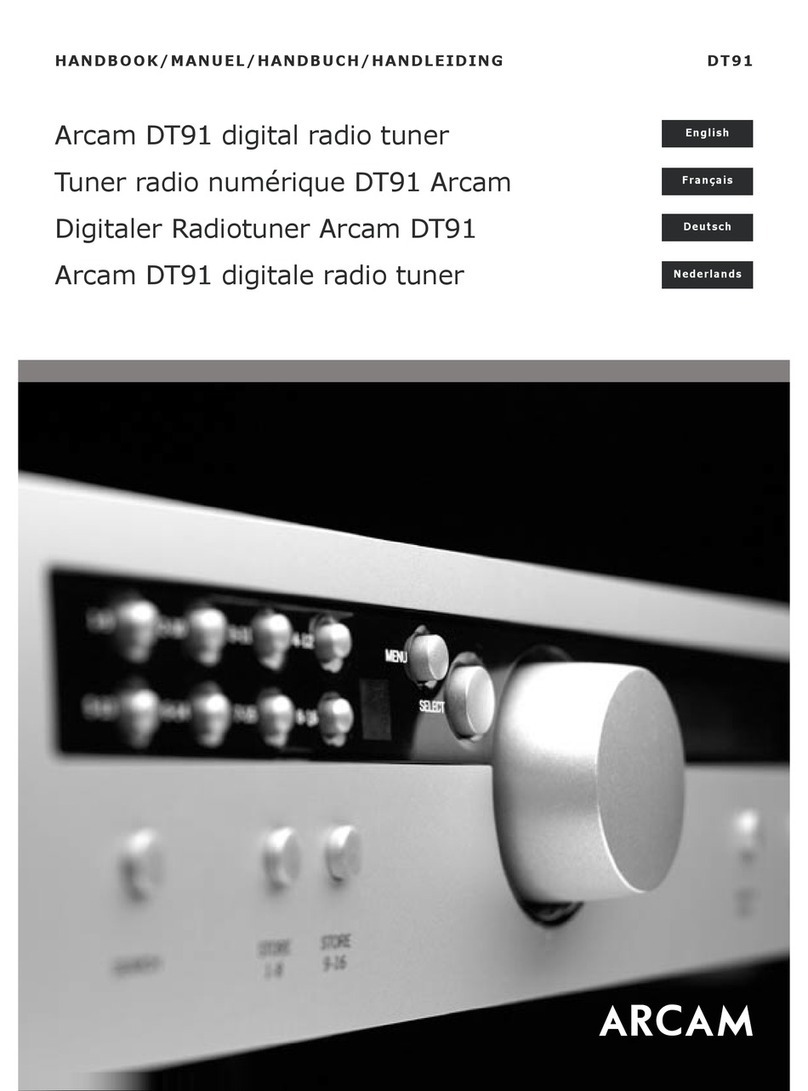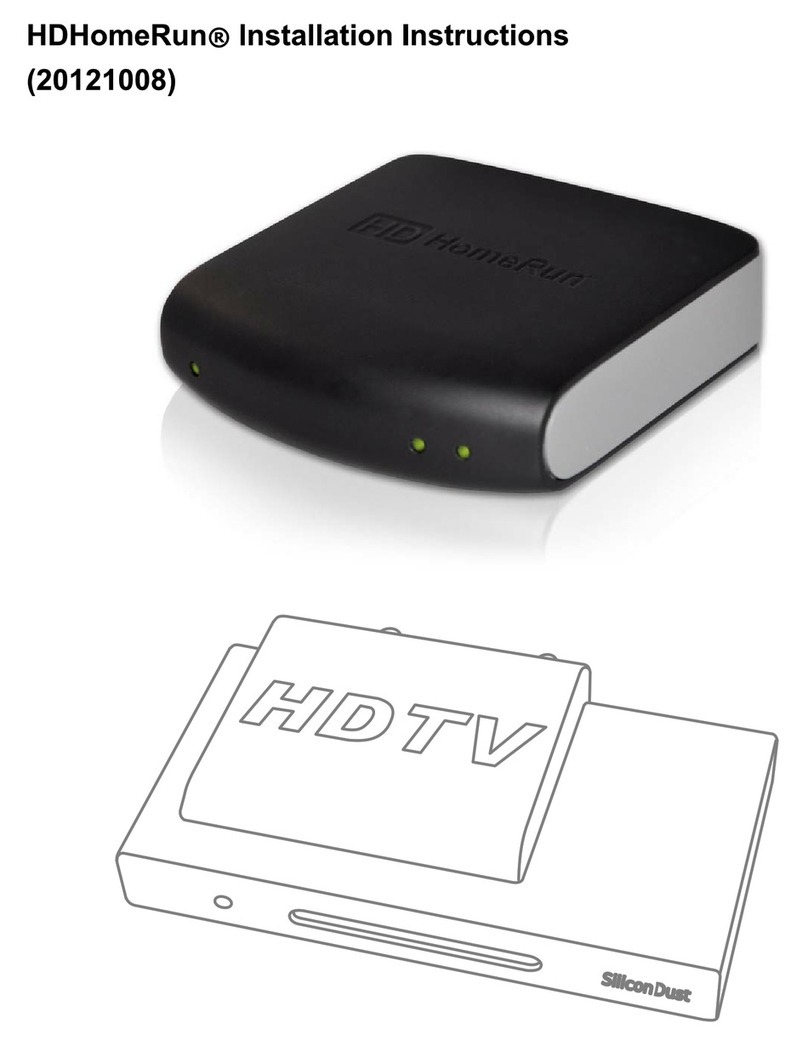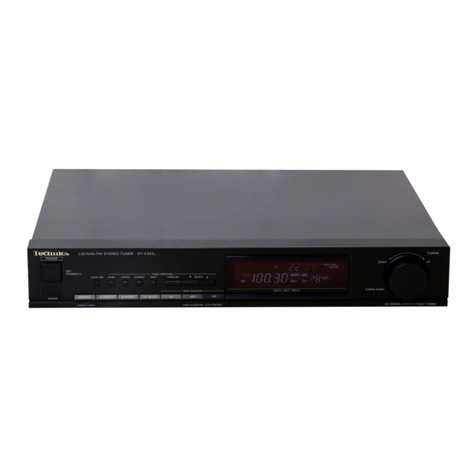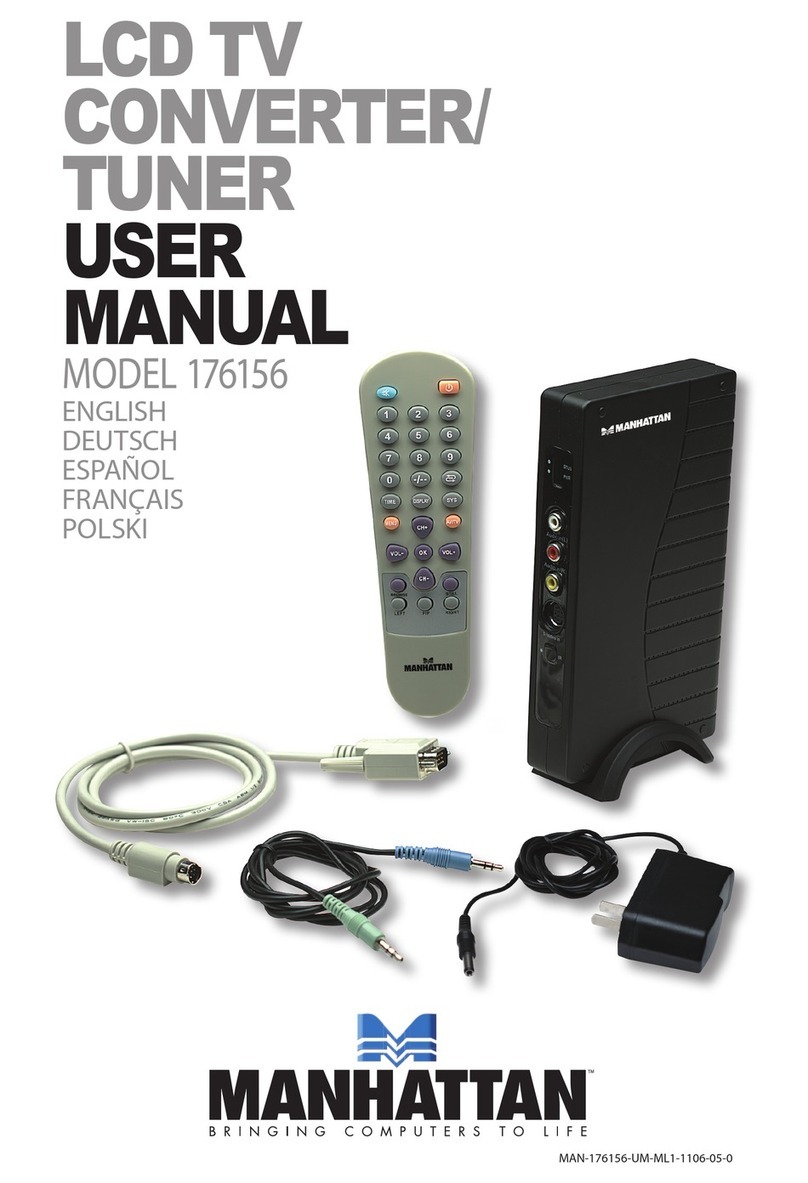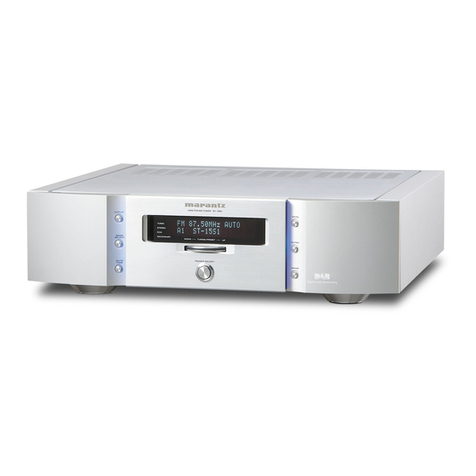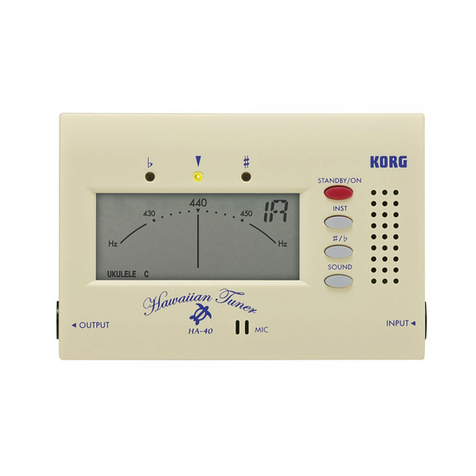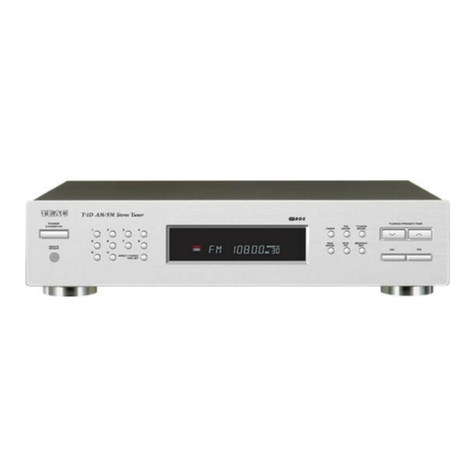Caution
1To avoid short circuit, electric shock or malfunction:
Do not disassemble for repair.
Do not place in high temperature and humid space such as electric
heater, direct sunlight, bathroom, wet floor etc.
Do not place in excessive vibration.
Do not place in dusty or dirty space.
Do not operate the tuner with wet hands.
2To avoid breakdown
Do not handle all controls with excessive power.
Do not drop the tuner.
3Cleaning
Do not use thinner or alcohol for cleaning.
Use only dry and clean cloth.
4To prevent battery loss
Remove the battery when the tuner is not in use for a long time.
Turn the power button off when the tuner is not in use.
5Battery
Use only 3V battery : AAA Size (R03, LR03, L30) ×2
Features & Functions
1POWER button for ON/OFF
The power will be turned ON & OFF by each press of POWER button.
This tuner will be turned OFF after 20 minutes automatically.
2MODE button for AUTO/MAN selection
Following modes will be indicated on LCD in order by each press of
MODE button.
AUTO- MAN- AUTO- MAN
3FUNCTION button for Function selection
Following modes will be indicated on LCD in order by each press of
FUNCTION button.
PITCH - FLAT - PITCH - FLAT
NOTE Function will be indicated on LCD when you select MAN Mode.
4ADJUST button for FUNCTION modes
i) Pitch Adjust : Reference Pitch Setting (Calibration)
You can set the calibration by each press of ADJUST button.
Calibration Range : 435Hz - 445Hz (1Hz step)
ii) Note Adjust : Tuning Note Selection
When you wish to tune in MAN mode, you can select the note you
wish to tune by each press of ADJUST button.
Note : A (La), A#, B (Si), C (Do), C#, D (Re), D#, E (Mi), F (Fa), F#,
G (Sol), G#
iii) Flat Adjust : Flat Selection
You can use the Flat mode to tune to a pitch that is lowered by 1~2
semitones ( /) for the specified note.
Press the ADJUST button to select the semitones
( /)
that you
wish to lower and Flat modes will be indicated on LCD one by one.
5SOUND button for Sound Output
Connect the OUTPUT jack of tuner to a input jack of amplifier and
you can tune your instruments by hearing the standard sound from
amplifier.
When you press SOUND button, SOUND mode will be indicated on
LCD and tuning needles will not shown on LCD.
Sound Note will circulate according to the order A, A#, B, C, C#, D, D#,
E, F, F#, G, G# whenever you press the ADJUST button.
You can hear the sound flatten by 1~2 semitones ( /) you wish by
each press of ADJUST button after you select the Flat Function with
FUNCTION button in Sound Mode.
If you press SOUND button once more, it will go back to Tuning Mode.
6Liquid Crystal Display (LCD)
* Initial setting on LCD:MODE=AUTO, FUNCTION=PITCH,
Calibration=440Hz
These settings will be initialized when the power is turned on.
aMode : AUTO / MAN
bNote of Instruments
cFunction Indicator
d/#: When the string is in tune, tuning needle stop in the center "0"
then /# will be indicated on LCD.
If the pitch of string is flat, will be indicated on LCD.
If the pitch of string is sharp, # will be indicated on LCD.
eFlat indicator
f
Reference pitch (Calibration) : Indicates the current calibration value.
gTuning meter
When the string is in tune, Tuning needle stops in the center “0”.
7INPUT Jack Electric & Electronic instruments
When you wish to tune electric stringed instruments, connect the out-
put cord or pickup of the instrument to the INPUT jack of tuner.
The MICROPHONE do not operate when the INPUT jack is connected
with instrument.
8OUTPUT jack for connection amplifier
If you to monitor the sound of instrument, connect the OUTPUT jack of
tuner to the Input jack of amplifier. You can monitor the sound of in-
strument regardless of tuner ON/OFF. When you play the instrument,
be sure to turn OFF the power of tuner to prevent the hum noise from
tuner.
9MICROPHONE For Acoustic Stringed Instruments
When you wish to tune acoustic stringed instruments, locate this tuner
near the instrument for more accurate tuning. This MICROPHONE do
not operate when the INPUT jack is connected with instrument.
0Tuning Guide LEDs
These LEDs will help the discrimination of tuning process.
When the instrument is in tune, Tuning needle stops in the center “0”.
Then,the Green LED in the middle will light up. If the pitch of string is
flat,the Red LED in the left will light up. If the pitch of string is sharp,
the Red LED in the right will light up.
Tuning Procedure
For accurate Tuning
• Do not operate the tuner nearby sound equipment such as Radios
or Televisions, if possible. These units can be impediment in recep-
tion of exact sound by internal Microcomputer.
• Locate the volume level of electric stringed instruments at center
position for reasonable sound input.
• Do not pluck loudly and heavily.
• When you tune the stringed instrument, do not pluck loudly and if
you want quick tuning of next string, press all strings with fingure
lightly after current tuning to cut sound input of current tuning string.
Auto Tuning in Auto Mode
1.
Electric & Electronic instruments : Connect output cord of the instrument to
the INPUT jack of tuner and if possible, adjust the volume level of the in-
strument to center position. If you wish to monitor the sound of the instru-
ment, connect the OUTPUT jack of tuner to the INPUT jack of amplification.
You can monitor the sound of instrument regardless of tuner ON/OFF.
Acoustic stringed instruments : Locate the instrument near the MIC in tuner.
2. Press the POWER button to turn the tuner ON. The LCD lights up
and LCD is automatically set to the AUTO GUITAR mode and stan-
dard reference pitch 440Hz.
3. Adjust the reference pitch by PITCH button, if necessary.
4. Try the tuning from low frequency string.
5. If the pitch of tuning string is greater than -50 or +50 cents from the
exact pitch, adjust the instrument until one of the LEDs lights up
and the tuning note you wish to tune is indicated on LCD. If pitch of
the tuning string is within -50 or +50 cents, tighten or loosen the
string slowly to approach the needle of meter to the center “0”.
6.
When the needle of LCD meter stops in the center “0”, the Green LED in
the middle will light up and /# will be indicated simultaneously on LCD.
This point is exact sound of the string.
Manual Tuning in Man Mode
1. Electric & Electronic instruments : Connect output cord of the in-
strument to the INPUT jack of tuner and if possible, adjust the vol-
ume level of the instrument to center position. If you wish to moni-
tor the sound of the instrument, connect the OUTPUT jack of tuner
to the INPUT jack of amplification.
2. Press the POWER button to turn the tuner ON. The LCD lights up
and LCD is automatically set to the AUTO mode and standard ref-
erence pitch 440Hz.
3. Adjust the reference pitch by PITCH button, if necessary.
4. Press MODE Button once, MAN & A (Note) will be indicated on LCD
Then, select the note you wish to tune by each press of Adjust but-
ton. If the note you wish to tune is indicated on LCD, try the tuning
from the low frequency.
5. If the pitch of tuning string is greater than -50 or +50 cents from the
exact pitch, adjust the instrument until one of the LEDs lights up
and the tuning note you wish to tune is indicated on LCD. If pitch of
the tuning string is within -50 or +50 cents, adjust the instrument
slowly to approach the needle of meter to the center “0”.
6.
When the needle of LCD meter stops in the center “0”, the Green LED in
the middle will light up and & # will be indicated simultaneously on LCD.
This point is exact sound of the string.
Tuning by Sound
1. Press the SOUND button, the mode will switch to MAN, and the
FUNCTION will switch to NOTE.
A will be displayed for NOTE and the corresponding sound will be generated
.
2.
You can compare and tune while listening to sound generated from the
amplifier connected to the OUTPUT jack with the pitch of your instrument.
3. If necessary, adjust NOTE or FLAT to perform tuning.
Notice: The sound level can be subjected to decrease depending
on the instrument output impedance.
When either Volume or Tone control turns aniti-clockwise fully, no
sound comes out.
Installation & Replacement of Battery
1. Slide the battery cover on bottom
side in the direction of the tuner
arrow while pressing the cover.
2. Fix AAA Size (R03, LR03, L30) ×2
- 3V battery into correct polarity
of battery terminal and insert it in
the battery space.
3. Slide the battery cover on the
contrary.
* This tuner is very convenient for
users to monitor its display on
LCD, because it is a little inclined
to be more stable.
Specifications
Mode : Auto & Manual Tuning Modes
Tuning Range : A0 (27.50Hz)~C8 (4,186.00Hz)
Tuning Note : A (La), A#, B (Si), C (Do), C#, D (Re), D#, E (Mi), F (Fa), F#,
G (Sol), G#
Flat Function : 1~2 semitones ( / )
Accuracy :+/- 1 Cent
Calibration : 435 ~ 445Hz (1Hz step)
Indicator : LCD & 3LEDs
Input : Condenser Microphone for Acoustic, Input Jack for Electric
Output : Output Jack for connection with Amplifier
Power : 3V Battery - AAA size (R03, LR03, L30) ×2
Dimensions : 105 (W) ×68 (D) ×25 (H) mm
Weight : 120g (Including Battery)
* The design and specifications are subject to change without prior
notice for product improvement.
This is to certify that Chromatic Tuner CU20 is in conformity with
: Council Directive 89/336/EEC (EMC Directive)
Applicable Standards :
EN50081-1 : .92
Electromagnetic Compatibility-Generic emission standard.
Part 1 :
Residential, commercial and light industry.
EN50082-1 : 01.97
Electromagnetic Compatibility-Generic immunity standard.
Part 1 :
Residential, commercial and light industry.
CHROMATIC TUNER
CU20
USER’S MANUAL
Prudence
1
Pour éviter des court-circuits, des électrocutions ou des dysfonctionnements:
N’essayez jamais de démonter cet appareil.
Evitez de placer l’appareil dans des endroits soumis à une chaleur ou
une humidité excessive. Exemples: près d’un radiateur, en plein soleil,
dans une salle de bains, sur un sol humide, etc.
Evitez de soumettre l’appareil à de fortes vibrations.
Evitez les endroits poussiéreux et sales.
Ne manipulez jamais cet accordeur avec des mains mouillées.
2Pour éviter des dysfonctionnements
Manipulez les commandes avec soin.
Ne laissez jamais tomber cet accordeur.
3Nettoyage
N’utilisez jamais de détergent ou du benzène pour le nettoyage.
Nettoyez l’appareil avec un chiffon sec et doux.
4Pour économiser la pile
Si vous ne pensez pas utiliser cet appareil durant une longue période, retirez la pile.
Mettez l’accordeur hors tension tant que vous n’en avez pas besoin.
5Pile
Utilisez une pile 3V de taille AAA (R03, LR03, L30) ×2
Fonctions de l’accordeur
1Bouton POWER pour la mise sous/hors tension
En appuyant plusieurs fois sur le bouton POWER, vous mettez l’appareil
sous et hors tension.
Au bout de 20 minutes, l’accordeur se coupe automatiquement.
2Bouton MODE pour la sélection AUTO/MAN
Le bouton MODE permet de sélectionner plusieurs modes que vous
choisissez en appuyant plusieurs fois sur ce bouton.
AUTO- MAN- AUTO- MAN
3Bouton FUNCTION pour la sélection de la fonction souhaitée
Le bouton FUNCTION permet de sélectionner plusieurs modes que
vous choisissez en appuyant plusieurs fois sur ce bouton.
PITCH - FLAT - PITCH - FLAT
REMARQUE La fonction choisie est uniquement affichée à l’écran si
vous passez en mode MAN.
4Bouton ADJUST pour les modes FUNCTION
i)
Choix de la hauteur: permet de choisir la hauteur de référence (calibrage)
Choisissez la fréquence de référence en appuyant plusieurs fois
sur le bouton ADJUST.
Plage de réglage: 435Hz - 445Hz (par pas de 1Hz)
ii) Choix de la note: permet de choisir la note devant être accordée
Si vous préférez accorder votre instrument en mode MAN, vous
devez choisir la note avec le bouton ADJUST.
Notes disponibles : A (La), A#, B (Si), C (Do), C#, D (Re), D#, E (Mi), F (Fa), F#, G (Sol), G#
iii) Réglage alternatif: permet de choisir un mode "bémol"
Le mode "Flat" permet d’accorder votre instrument par rapport à
une référence abaissée d’1 ou de 2 demi-tons ( / ).
Utilisez le bouton ADJUST pour choisir le nombre de demi-tons ( / )
correspondant au décalage souhaité. Ce réglage est affiché à l’écran.
5Bouton SOUND pour la reproduction des notes de référence
Reliez la prise OUTPUT de l’accordeur à l’entrée ad hoc de votre amplificateur
si vous souhaitez entendre les notes de référence pendant l’accord.
Lorsque vous appuyez sur le bouton SOUND, le mode SOUND est
affiché à l’écran. Dans ce cas, les aiguilles d’accord disparaissent.
Les notes pouvant être jouées sont 5A-4D-3G-2B-1E-7B-6E;
choisissez-les en appuyant plusieurs fois sur le bouton ADJUST.
Tant que le bouton FUNCTION indique le mode Sound, les notes choisies
peuvent être abaissées d’1 ou de 2 demi-tons ( /) en sélectionnant
le mode
"
Flat
"
et en appuyant ensuite sur le bouton ADJUST.
Appuyez une fois de plus sur le bouton SOUND pour repasser en mode d’accord.
6Affichage à cristaux liquides (LCD)
* Réglage initial de l’écran LCD: MODE= AUTO, Function= PITCH,
Calibrage= 440Hz
Ces réglages sont utilisés chaque fois que vous mettez l’accordeur sous tension.
aMode : AUTO/MAN
bNotes des différents instruments
cIndicateur de fonction
d/#: Lorsque la corde est bien accordée, l'aiguille s'arrête au milieu
("0"). Ensuite, l'écran LCD affiche /#.
Si la corde est trop basse, apparaît à l’écran LCD.
Si la corde est trop haute, # apparaît à l’écran LCD.
eIndicateur "trop bas"
f
Hauteur de référence (calibrage) : Indique la fréquence de référence en vigueur.
gMètre
Lorsqu’une corde est accordée, l’aiguille se trouve au milieu ("0").
7Prise INPUT pour instruments électriques & électroniques
Pour accorder des instruments à cordes électriques, vous devez connecter
la sortie de l’instrument à la prise INPUT de l’accordeur. Lorsque vous
connectez un instrument à la prise INPUT, le MICROPHONE est coupé.
8Prise OUTPUT pour la connexion à un amplificateur
Pour entendre le signal de l’instrument, vous devez connecter la prise OUT-
PUT de l’accordeur à l’entrée ad hoc d’un amplificateur. Le signal de
l’instrument est toujours retransmis par la sortie de l’accordeur. Peu importe
donc si ce dernier est allumé ou éteint. Avant de vous mettre à jouer pour de
bon, mettez l’accordeur hors tension pour éviter tout souffle ou bourdonnement.
9MICROPHONE pour instruments à cordes acoustiques
Si vous souhaitez accorder des instruments à cordes acoustiques, rapprochez-
en l’accordeur le plus possible afin d’obtenir un accord optimal. Le MICRO-
PHONE est coupé dès que vous connectez un câble à la prise INPUT.
0Témoins de référence pour l’accord
Ces témoins vous aideront à voir si votre instrument est bien accordé.
Lorsqu’une corde est accordée, l’aiguille se trouve au milieu (
"
0
"
).
De plus, le témoin vert au milieu s’allume. Si la corde est trop basse, le
témoin rouge à gauche s’allume. Si la corde est trop haute, le témoin
rouge à droite s’allume.
Conseils pour bien accorder votre instrument
Pour accorder votre instrument avec le maximum de précision
• Evitez, dans la mesure du possible, de placer votre accordeur près
d’un poste de radio ou de télévision. De telles unités peuvent en
effet entraver la détection de la hauteur effectuée par le micro-
ordinateur de l’accordeur.
• Réglez la commande de volume de l’instrument au milieu pour
obtenir un niveau d’entrée acceptable du côté de l’accordeur.
• Evitez de frapper les cordes et de les pincer de façon exagérée.
•
Pour accorder des instruments à cordes, évitez de tirer trop fort sur
les cordes, voire d'en pincer plusieurs à la fois. Après avoir accordé
une corde, il convient en outre de l'étouffer avant d'entamer la suivante.
Accord automatique en mode Auto
1. Instruments électriques & électroniques :
Reliez le câble de l’instrument à la prise INPUT de l’accordeur (si possible) et
réglez le volume de l’instrument au milieu. Pour entendre le signal de
l’instrument, vous devez connecter la prise OUTPUT de l’accordeur à l’entrée
ad hoc d’un amplificateur. Le signal de l’instrument est toujours retransmis par
la sortie de l’accordeur. Peu importe donc si ce dernier est allumé ou éteint.
Instruments à cordes acoustiques:
Rapprochez l’instrument le plus possible du microphone (MIC) de l’accordeur.
2. Appuyez sur le bouton POWER pour mettre l’accordeur sous ten-
sion. L’écran LCD s’allume et passe automatiquement en mode
AUTO. La fréquence de référence est réglée à 440Hz.
3.
En cas de besoin, vous pouvez modifier la hauteur avec le bouton PITCH.
4. Essayez d’abord d’accorder une corde grave.
5. Si l’écart entre l’accord actuel de la corde choisie est supérieur à
-50 ou +50 cent par rapport à la hauteur juste, changez la hauteur
de cette corde jusqu’à ce que l’un des témoins s’allume et que le
nom de la note soit affiché à l’écran. Dès que la hauteur de la note
se trouve à moins de –50 ou +50 cents de la hauteur juste, changez
l’accord jusqu’à ce que l’aiguille se trouve au centre (
"
0
"
).
6. Lorsqu’une corde est accordée, l’aiguille se trouve au milieu (
"
0
"
),
alors que l’écran LCD affiche
"
/#
"
. De plus, le témoin vert au mi-
lieu s’allume. L’accord de la corde est désormais parfait.
Accord manuel en mode MAN
1. Instruments électriques & électroniques :
Reliez le câble de l’instrument à la prise INPUT de l’accordeur (si possible) et réglez
le volume de l’instrument au milieu. Pour entendre le signal de l’instrument, vous
devez connecter la prise OUTPUT de l’accordeur à l’entrée ad hoc d’un amplificateur.
2.
Appuyez sur le bouton POWER pour mettre l’accordeur sous tension. L’écran LCD s’allume
et passe automatiquement en mode AUTO. La fréquence de référence est réglée à 440Hz.
3.
En cas de besoin, vous pouvez modifier la hauteur avec le bouton PITCH.
4.
Appuyez une fois sur le bouton MODE. L’écran LCD affiche alors
"
MAN
"
&
"
A
"
(note). Choisissez ensuite la note devant être accordée en appuyant une ou
plusieurs fois sur le bouton ADJUST. Si le nom de la note que vous souhaitez
accorder est affiché à l’écran LCD, accordez la corde en question
"
depuis le bas
"
.
5.
Si l’écart entre l’accord actuel de la corde choisie est supérieur à –50 ou +50
cent par rapport à la hauteur juste, changez la hauteur de cette corde jusqu’à ce
que l’un des témoins s’allume et que le nom de la note soit affiché à l’écran. Dès
que la hauteur de la note se trouve à moins de –50 ou +50 cents de la hauteur
juste, changez l’accord jusqu’à ce que l’aiguille se trouve au centre (
"
0
"
).
6.
Lorsqu’une corde est accordée, l’aiguille se trouve au milieu ("0"), alors que l’écran LCD affiche
" /#". De plus, le témoin vert au milieu s’allume. L’accord de la corde est désormais parfait.
Accord avec des notes pilote
1. Appuyez sur le bouton SOUND pour sélectionner le mode MAN et
activer la fonction NOTE.
A côté de "NOTE" apparaît la lettre "A" (La) et vous entendez cette note.
2.
Comparez la hauteur de votre instrument avec celle de la note jouée via l'amplificateur
(relié à la prise OUTPUT de l'accordeur) et effectuez les changements qui s'imposent.
3. En cas de besoin, vous pouvez modifier les réglages NOTE et FLAT
pour accorder l'instrument de la manière escomptée.
Remarque: Le volume du signal dépend très fort de l'impédance de l'instrument connecté.
Lorsque la commande VOLUME ou TONE CONTROL de l’instrument se trouve
tout à fait à gauche, aucun signal n’est transmis.
Installer et remplacer la pile
1. Faites glisser le couvercle au dos
de l’accordeur vers la flèche en
appuyant dessus.
2.
Insérez une pile de taille AAA (R03,
LR03, L30) ×2 - 3V dans l’unité pour
piles, en respectant la polarité, puis
remettez l’unité dans le compartiment.
3. Faites glisser le couvercle dans
le sens opposé.
*
Un des avantages de cet accordeur
est son écran LCD légèrement
incliné et dès lors plus lisible.
Fiche technique
Mode: accord automatique et manuel
Fréquences reconnues : A0 (27.50Hz)~C8 (4,186.00Hz)
Notes pour l’accord: A (La), A#, B (Si), C (Do), C#, D (Re), D#, E (Mi), F
(Fa), F#, G (Sol), G#
Fonction Flat (
"
bémol
"
) : 1~2 demi-tons (
/
)
Précision: ±1 cent
Calibrage : 435 ~ 445Hz (par pas de 1Hz)
Témoins : écran LCD, 3 témoins à DEL
Entrées : microphone à condensateur pour instruments acoustiques,
prise INPUT pour instruments électriques
Sorties : prise OUTPUT pour la connexion à un amplificateur
Alimentation: pile 3V de taille AAA (R03, LR03, L30) ×2
Dimensions: 105 (L) ×68 (P) ×25 (H) mm
Poids : 120g (pile comprise)
* Les caractéristiques et la présentation sont susceptibles d’être
modifiés sans avis préalable.
Par la présente, nous certifions que l’accordeur chromatique CU20 se
conforme à: Directive du Conseil 89/336/EEC (directive EMC)
Normes étant d’application :
EN50081-1 : .92
Compatibilité électromagnétique – norme générale d’émission.
Partie 1:
Résidentiel, commercial, industrie légère.
EN50082-1 : 01.97
Compatibilité électromagnétique – norme générale d’immunité.
Partie 1:
Résidentiel, commercial, industrie légère.
ACCORDEUR CHROMATIQUE
CU20
MODE D’EMPLOI
Achtung
1Kurzschlüsse, elektrische Schläge und Fehlfunktionen vermeiden:
Öffnen Sie niemals das Gerät.
Lagern Sie das Gerät nicht an extrem heißen oder feuchten Orten, wie beispielsweise
auf einer Heizung, im direkten Sonnenlicht, im Bad oder auf einem feuchten Fußboden.
Setzen Sie das Gerät keinen starken Erschütterungen aus.
Lagern Sie das Gerät nicht an staubigen oder verschmutzten Orten.
Bedienen Sie das Gerät nicht mit nassen Händen.
2Schäden vermeiden
Bedienen Sie die Steuerelemente nicht mit übermäßiger Kraft.
Achten Sie darauf, das Stimmgerät nicht fallen zu lassen.
3Reinigung
Verwenden Sie kein Lösemittel oder Alkohol zur Reinigung, sondern
nur ein trockenes, sauberes Tuch.
4Batterieverbrauch minimieren
Nehmen Sie die Batterie aus dem Stimmgerät heraus, sollte es längere
Zeit nicht benutzt werden.
Schalten Sie das Stimmgerät immer aus, wenn es nicht benutzt wird.
5Batterie
Es werden zwei 3-V-Batterien im AAA-Format benötigt (R03, LR03, L30).
Merkmale und Funktionen
1Taste POWER zum Ein- und Ausschalten
Das Gerät lässt sich mit dieser Taste einschalten und durch erneutes
Drücken wieder ausschalten. Es schaltet sich automatisch aus, wenn
es 20 Minuten lang nicht benutzt wurde.
2
Taste MODE für die Wahl der Betriebsart: AUTO/MAN (automatisch/manuell)
Die folgenden Betriebsarten werden nacheinander bei jedem Drücken
der Taste MODE auf dem LCD angezeigt:
AUTO- MAN- AUTO- MAN
3Taste FUNCTION zur Funktionswahl
Die folgenden Modi werden nacheinander bei jedem Drücken der Taste
FUNCTION auf dem LCD angezeigt:
PITCH - FLAT - PITCH - FLAT
Die Funktion NOTE wird auf dem LCD angezeigt, wenn Sie die Betriebsart MAN wählen.
4Taste ADJUST für die FUNCTION-Betriebsarten
i) Tonhöheneinstellung: Einstellung der Referenztonhöhe (Kalibrierung)
Das Gerät kann durch Drücken der Taste ADJUST kalibriert werden.
Kalibrierungsbereich: 435 Hz bis 445 Hz (in 1-Hz-Schritten)
ii) Toneinstellung: Wahl der zu stimmenden Tons
Wenn Sie in der Betriebsart MAN stimmen wollen, können Sie den zu
stimmenden Ton durch wiederholtes Drücken der Taste ADJUST wählen.
Note: A (La), A#, B (Si, das deutsche H), C (Do), C#, D (Re), D#, E (Mi), F (Fa), F#, G (Sol), G#
iii) Tiefalterationsmodus
Sie können den Tiefalterationsmodus (Flat Mode) verwenden, um
auf eine Tonhöhe zu stimmen, die gegenüber dem gewählten Ton 1
oder 2 Halbtöne ( /) tiefer ist als der Bezugston.
Mit der Taste ADJUST können Sie die Halbtöne ( /) wählen, die Sie verringern
wollen, und die Tiefalterationsmodi werden nacheinander auf dem LCD angezeigt.
5Taste SOUND für Klangausgabe
Verbinden Sie die Buchse OUTPUT des Stimmgeräts mit einem
Verstärkereingang, und Sie können dann Ihre Instrumente stimmen und
dabei die gewohnte Wiedergabe über den Verstärker hören.
Wenn Sie die Taste SOUND drücken, wird die Betriebsart SOUND auf
dem LCD angezeigt; die Zeigernadeln werden nicht mehr angezeigt.
Die Töne werden in der Abfolge 5A-4D-3G-2B-1E-7B-6E mit der Taste ADJUST „durchgeschaltet“.
Wenn Sie den Tiefalterationsmodus (Flat Mode) - mit der Taste FUNC-
TION in der Betriebsart Sound - gewählt haben, hören Sie, wie sich die
Tonhöhe mit jedem Drücken der Adjust-Taste um einen Halbton ( /).
Wenn Sie die Taste SOUND nochmals drücken, kehrt das Gerät in die Betriebsart Tuning zurück.
6Flüssigkristallanzeige (Liquid Crystal Display - LCD)
* Standardeinstellung auf dem LCD: MODE = AUTO, Function = PITCH,
Calibration = 440 Hz
Diese Einstellungen sind nach dem Einschalten des Geräts aktiv.
aBetriebsart: AUTO/MAN
bNote des Instruments
cFunktionsanzeige
d/#: Wenn die Saite gestimmt ist, stoppt die Zeigernadel auf dem
mittleren “0”, und gleichzeitig wird dann /# auf dem LCD angezeigt.
Wenn die Saite zu tief gestimmt ist, wird auf dem LCD angezeigt.
Wenn die Saite zu hoch gestimmt ist, wird # auf dem LCD angezeigt.
eFlat-Anzeige
f
Referenztonhöhe (Kalibrierung): zeigt die aktuelle Kalibrierungseinstellung an.
gStimmanzeige
Wenn die Saite gestimmt ist, stoppt die Zeigernadel auf der mittleren “0”.
7Buchse INPUT für elektrische und elektronische Instrumente
Wenn Sie elektrische Saiteninstrumente stimmen wollen, schließen Sie das
Signalkabel oder das Pickup des Instruments an die Buchse INPUT des Stimmgeräts.
Solange an der Buchse INPUT ein Instrument angeschlossen ist, ist das Mikrofon außer Funktion.
8Buchse OUTPUT zum Anschluss an einen Verstärker
Wenn Sie den Klang des Instruments hören wollen, schließen Sie die Buchse
OUTPUT des Stimmgeräts an die Eingangsbuchse eines Verstärkers. Das In-
strument können Sie auch dann über den Verstärker hören, wenn das Stimmgerät
ausgeschaltet ist. Wenn Sie das Instrument spielen, sollten Sie das Stimmgerät
ausschalten, um eventuelle Störungen durch das Stimmgerät auszuschließen.
9Mikrofon für akustische Saiteninstrumente
Wenn Sie ein akustisches Saiteninstrument stimmen wollen, platzieren Sie dieses
Stimmgerät nahe am Instrument, um ein präzises Stimmen zu ermöglichen. Das Mikrofon
ist außer Funktion, wenn an der Buchse INPUT ein Instrument angeschlossen ist.
0Stimm-LEDs
Diese LEDs unterstützen den Stimmvorgang.
Ist die gewünschte Stimmung erreicht, stoppt die Anzeigenadel auf
der mittleren “0” und die grüne LED in der Mitte leuchtet permanent.
Wenn die Tonhöhe der Saite zu tief ist („flat“) ist, leuchtet die linke rote LED auf.
Wenn die Tonhöhe der Saite zu hoch ist („sharp“), leuchtet die linke rote LED auf.
Stimmen
Für präzises Stimmen beachten
•
Verwenden Sie das Stimmgerät möglichst nicht in unmittelbarer Nähe von
potentiellen Störquellen wie Radios oder Fernsehgeräten. Solche Geräte können
die Aufnahme des Klangs durch den internen Microcomputer beeinflussen.
• Stellen Sie gegebenenfalls die Lautstärkeregler von elektrischen
Saiteninstrumenten auf die Mittelstellung, um eine Übersteuerung
des Stimmgeräte-Eingangs zu vermeiden.
• Zupfen Sie nicht zu laut und hart.
• Wenn Sie ein Saiteninstrument stimmen, sollten Sie nicht zu hart
zupfen; wenn Sie sofort die nächste Saite stimmen wollen, sollten
Sie zuvor nachklingende Saiten mit der flachen Hand abdämpfen.
Automatisches Stimmen in der Betriebsart AUTO
1.
Elektrische und elektronische Instrumente: Stecken Sie das Signalkabel des
Instruments in die Buchse INPUT des Stimmgeräts, und, wenn möglich, regeln
Sie die Lautstärke des Instruments auf die Mittelstellung. Wenn Sie den Klang
des Instruments hören wollen, verbinden Sie die Buchse OUTPUT des
Stimmgeräts mit Eingang eines Verstärkers. Das Instrument können Sie auch
dann über den Verstärker hören, wenn das Stimmgerät ausgeschaltet ist.
Akustische Saiteninstrumente: Platzieren Sie das Instrument nahe des Stimmgerät-Mikrofons.
2.
Schalten Sie das Stimmgerät mit der Taste POWER ein. Das LCD leuchtet
auf, und das LCD wird automatisch in die Betriebsart AUTO GUITAR
versetzt und auf die Standardreferenztonhöhe von 440 Hz eingestellt.
3.
Stellen Sie, falls nötig, die Referenztonhöhe mit der Taste PITCH ein.
4. Beginnen Sie das Stimmen mit der tiefsten Saite.
5.
Wenn die Höhe der zu stimmenden Saite mehr als -50 oder +50 Cents von der exakten
Höhe abweicht, stimmen Sie das Instrument, bis eine der LEDs aufleuchtet und der
Ton, auf den Sie stimmen wollen, auf dem LCD angezeigt wird. Wenn sich der Ton
innerhalb eines Bereichs von -50 bis +50 Cents befindet, spannen oder lösen Sie die
Saite langsam, bis sich die Anzeigenadel auf der „0“ in der Mitte befindet.
6. Wenn die Nadel der LCD-Anzeige auf der mittleren “0” stoppt, die
grüne LED in der Mitte permanent leuchtet und auf dem LCD /#
erscheint, ist die gewünschte Stimmung erreicht.
Manuelles Stimmen in der Betriebsart MAN
1.
Elektrische und elektronische Instrumente: Stecken Sie das Signalkabel
des Instruments in die Buchse INPUT des Stimmgeräts, und wenn
möglich, regeln Sie die Lautstärke des Instruments auf die Mittelstellung.
Wenn Sie den Klang des Instruments hören wollen, verbinden Sie die
Buchse OUTPUT des Stimmgeräts mit Eingang eines Verstärkers.
2.
Schalten Sie das Stimmgerät mit der Taste POWER ein. Das LCD leuchtet
auf, und das LCD wird automatisch in die Betriebsart AUTO GUITAR
versetzt und auf die Standardreferenztonhöhe von 440 Hz eingestellt.
3.
Stellen Sie, falls nötig, die Referenztonhöhe mit der Taste PITCH ein.
4.
Drücken Sie die Taste MODE einmal; MAN & A (Note) wird auf dem LCD angezeigt.
Wählen Sie dann den Ton, den Sie stimmen wollen, indem Sie entsprechend oft
die Taste Adjust drücken. Sobald der Ton, den Sie stimmen wollen, auf dem
LCD angezeigt wird, beginnen Sie das Stimmen mit der tiefsten Saite.
5.
Wenn die Höhe der zu stimmenden Saite mehr als -50 oder +50 Cents von der exakten
Höhe abweicht, stimmen Sie das Instrument, bis eine der LEDs aufleuchtet und der Ton,
auf den Sie stimmen wollen, auf dem LCD angezeigt wird. Wenn die Höhe der zu
stimmenden Saite mehr als -50 oder +50 Cents von der exakten Höhe abweicht, spannen
oder lösen Sie die Saite langsam, bis sich die Anzeigenadel auf der „0“ in der Mitte befindet.
6. Wenn die Nadel der LCD-Anzeige auf der mittleren “0” stoppt, die
grüne LED in der Mitte permanent leuchtet und auf dem LCD /#
erscheint, ist die gewünschte Stimmung erreicht.
Stimmen nach Referenzton
1.
Drücken Sie die Taste SOUND. Die Betriebsart (MODE) wird auf MAN
umgeschaltet, und die Funktion (FUNCTION) wird auf NOTE umgeschaltet.
Als NOTE wird A angezeigt, und der entsprechende Klang wird erzeugt.
2. Vergleichen Sie nach Gehör die Tonhöhe des Tons, der über die
Buchse OUTPUT ausgegeben wird, mit der Tonhöhe des Instru-
ments, um bei Bedarf danach das Instrument grob zu stimmen.
3. Falls gewünscht, wählen Sie zum Stimmen NOTE oder FLAT.
Hinweis: Die Lautstärke sinkt dabei möglicherweise; dies ist abhängig
von der Ausgangsimpedanz des Instruments.
Es erfolgt keine Klangausgabe, wenn sich der Regler VOLUME oder
TONE CONTROL am Instrument in der äußerst linken Stellung befindet.
Einsetzen und tauschen der Batterien
1.
Schieben Sie die Batteriefachabdeckung
auf der Unterseite in Pfeilrichtung, während
Sie leicht auf die Abdeckung drücken.
2.
Legen Sie zwei Batterien (3 V, AAA
(R03, LR03, L30)) korrekt
ausgerichtet in das Batteriefach ein.
3. Schieben Sie die
Batteriefachabdeckung wieder zu.
*
Das LCD dieses Stimmgeräts lässt sich
bequem ablesen, da es etwas geneigt ist.
Technische Daten
Betriebsarten: automatisches und manuelles Stimmen (AUTO und MAN)
Stimmbereich: A0 (27,50 Hz) bis C8 (4.186,00 Hz)
Töne: A (La), A#, B (Si, das deutsche H), C (Do), C#, D (Re), D#, E (Mi), F (Fa), F#, G (Sol), G#
Tiefalterationsmodus: 1 bis 2 Halbtöne (
/
)
Genauigkeit: +/- 1 Cent
Kalibrierung: 435 - 445 Hz (1-Hz-Schritte)
Anzeigen: LCD und 3 LEDs
Eingang: Kondensatormikrofon für akustische Instrumente,
Eingangsbuchse für elektrische Instrumente
Ausgang: Ausgangsbuchse zum Anschluss an einen Verstärker
Stromversorgung: zwei 3-V-Batterien - AAA (R03, LR03, L30)
Abmessungen: 105 (B) ×68 (T) ×25 (H) mm
Gewicht: 120 g (mit Batterie)
*
Zur Vornahme von Produktverbesserungen behalten wir uns vor, Gestaltung
und technische Daten jederzeit ohne besonderen Hinweis zu ändern.
Hiermit wird die Konformität des Chromatisches stimmgerät CU20
mit der EU-Richtlinie 89/336/EEC bestätigt.
Relevante Vorschriften:
EN50081-1: .92
Elektromagnetische Kompatibilität – allgemeiner Emissionsvorschriften.
Teil 1:
Haushaltsgeräte, gewerbliche und leichtindustrielle Ausrüstung.
EN50082-1: 01.97
Elektromagnetische Kompatibilität – allgemeine Verträglichkeitsvorschriften.
Teil 1:
Haushaltsgeräte, gewerbliche und leichtindustrielle Ausrüstung.
CHROMATISCHES STIMMGERÄT
CU20
BEDIENUNGSANLEITUNG
